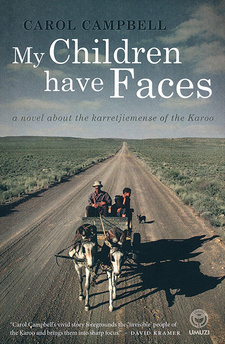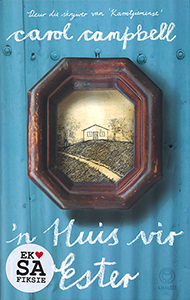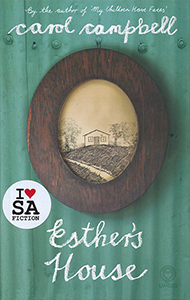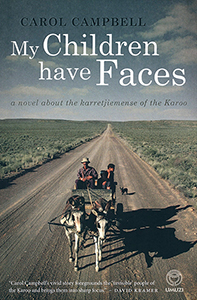My Children have Faces, by Carol Campbell

My Children have Faces, by Carol Campbell. Random House Struik Umuzi. Cape Town, South Africa 2014. ISBN 9781415201831 / ISBN 978-1-4152-0183-1
Vividly showing the invisible people of South Africa's Great Karoo, Carol Campbell’s thrilling novel, My Children have Faces, brings the nomadic karretjiemense to life.
[...] Since we left Leeu Gamka long ago I have moved like a dog on a chain. One end of the chain is attached to a pole hammered into hard earth and the other is rubbing my ankle raw. I make sure the chain never goes loose, but the pulling has made me very tired. I am not a dog and I cannot accept my chain is so short. I am thinking that if I don't break this chain, I am going to die. Many times when I sat under a pepper tree or walked next to the karretjie, I thought that to die from hunger or a snake bite would be better than living like this. If Liewe Jesus could have chosen a time, I would have been happy. I wanted my life to be over. But to die with the devil's thick fingers around my throat is what made me sit all night and watch the veld while everyone else slept. We have come back to Leeu Gamka so we can eat. It's shearing time on the farm Genade, and Baas Kobus sent a message for Kapok to come. So many missed seasons, but Baas Kobus told Diksop to tell Kapok he was wanted on Genade. Diksop is Kapok's sister and she and Gawie, her man, live in a real house on a farm near Rietbron. When Diksop found us we were at the uitspan at Seekoegat, and she gave Kapok the message. I saw him straighten up and he smiled and looked important and I knew we were going back. When Kapok was a boy his family uitspanned at Leeu Gamka before moving on to the farms for shearing. While the shearers worked, Baas Kobus, who was Klein Baas Kobus then, and Kapok ran together, stoning koggelmanders and shooting mossies with their ketties. Somewhere between it all, one learnt to be the baas and the other learnt to shear. Kapok could work eighty sheep a day when he was fed and healthy. Before he hurt his leg. "My record is thirty-five before brekfes," he boasted to our children. "Never, Pappie, we don't believe you." - "S'true. I will teach you one day, Fansie. Witpop, don't you believe your father is a strong man?" Those thirty-five sheep before breakfast were sheared when Kapok was still named Joseph. Strong Joseph, before the donkey karretjie tipped and crushed his leg, leaving him to hobble like a chicken, a kapok. I wonder if Baas Kobus knows he is Kapok now. I used to like farms like Genade. In the morning the women lit fires under the round, black, three-legged pots at the back door of the farmhouse and, before the sun was too hot, the smell of cooking afval and mieliepap would drive us all mad with hunger. The food was for the men. Meat helped their muscles, Kapok said. When it was dish-up time the girls spooned the food into their chipped enamel bowls and plastic tubs. Some farmers didn't give the workers food. Most places we bought tins and flour from the farm shop and paid for them with sheared sheep. But on Genade the workers ate. If any of the food was left, the Klein Mies gave the girls bread to wipe out the gravy before they washed the pots and put them away for the next day's lunch. In the middle of the afternoon everyone lined up again for a cup of sweet tea. Kapok said that was his favourite time, when the tired men drank tea and smoked Boxer Tobacco and joked who was the fastest shearer and strongest man. At the beginning of the shearing season Kapok held his stomach in the night as cramps came in waves, sending him running into the veld. "It is the milk in the tea, Muis," he said. "I am not used to it." - "You ate too much." I laughed. "Maybe it's the water on the farm." We both knew the cramps went away when he got used to eating every day. After the shearing time, the pain would come back but, this time, it would be from hunger. [...]
This is an excerpt from the novel: My Children have Faces, by Carol Campbell.
Title: My Children have Faces
Untertitel: A Novel about the Karretjiemense of the Karoo
Author: Carol Campbell
Genre: Fiktion
Publisher: Random House Struik
Imprint: Umuzi
Cape Town, South Africa 2014
ISBN 9781415201831 / ISBN 978-1-4152-0183-1
Softcover, 15 x 22 cm, 144 pages
Campbell, Carol im Namibiana-Buchangebot
'n Huis vir Ester
’n Huis vir Ester is ’n verhaal oor gierigheid, mag en diestryd om geregtigheid wanneer goeie mense besluit genoeg is genoeg.
Esther's House
Esther’s House is a South African story of greed, power, and the fight for what is right when good people are pushed too far.
My Children Have Faces: A Novel about the Karretjiemense of the Karoo
My Children have Faces is a suspenseful, moving novel about the nomadic karretjiemense of the Karoo in South Africa.



